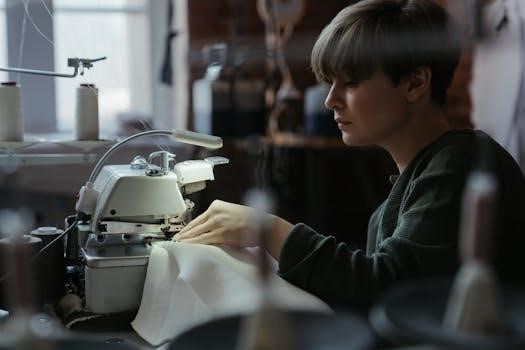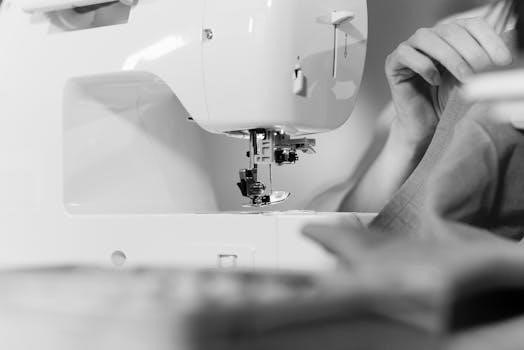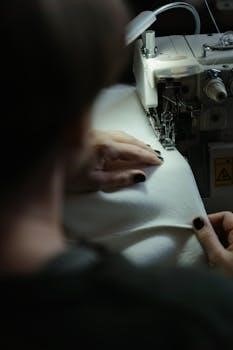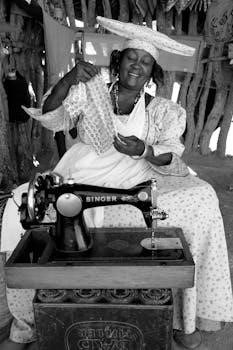The Singer 99K is a renowned vintage sewing machine, celebrated for its robust design and consistent performance, appealing to both sewing enthusiasts and collectors alike. This model was created as a compact version of the larger Singer 66.
Overview of the Singer 99K Model
The Singer 99K sewing machine is a notable model, recognized for its sturdy construction and dependable operation, making it a favorite among sewing machine collectors and users. Produced from the early part of the 20th century, the 99K was introduced as a smaller alternative to the larger Singer 66, while maintaining similar mechanical principles. This model came in both hand-crank and electric versions, offering versatility in its use. The 99K is considered a portable machine, known for its ease of use and ability to handle a range of sewing tasks. Its simple design makes it an excellent machine for beginners and experienced sewers alike. The availability of instruction manuals and online resources makes it easy to maintain and operate this iconic machine. The machine’s compact size does not compromise its performance, making it a reliable choice for various sewing projects.
Historical Significance of the 99K
The Singer 99K holds a significant place in sewing machine history, emerging in the early 20th century as a response to the need for a more compact yet capable machine. It represents a period of innovation in sewing technology when manufacturers focused on making machines accessible for home use. The 99K is a smaller, more portable version of the Singer 66, maintaining the quality and functionality associated with the Singer brand. This model played a crucial role in enabling more people to engage in sewing activities, marking a shift from industrial to domestic sewing. Its availability in both hand-crank and electric versions demonstrates the transition in technology during this time. The enduring popularity of the 99K is a testament to its reliable design and the impact it had on sewing culture. The continued interest in the 99K underscores its historical significance as a sewing machine that has stood the test of time.

Key Features and Components
The Singer 99K boasts a robust mechanical design, a reliable bobbin system, and essential parts that contribute to its enduring functionality. These features make it a favorite among sewing enthusiasts.
Mechanical Design and Construction
The Singer 99K sewing machine is celebrated for its durable mechanical design, built to withstand years of use. Its construction features a sturdy metal frame, ensuring stability and longevity. The internal mechanisms are engineered for precision, allowing for consistent stitch quality. The machine’s components work together seamlessly, creating a reliable and efficient sewing experience. The 99K’s robust build is a testament to the quality of vintage engineering. The design allows for both hand-crank and electric operation, offering flexibility for different sewing preferences. The simplicity of the mechanical design contributes to its ease of maintenance and repair. This thoughtful construction makes it a valuable machine for both beginners and experienced sewers. Its enduring design ensures it remains a favorite among those who appreciate vintage craftsmanship.
Understanding the Bobbin System
The Singer 99K utilizes a side-loading bobbin system, a common feature in many vintage sewing machines. This system involves a bobbin case that is accessed from the side of the machine, rather than from the front or top. The bobbin itself is a small spool that holds the thread for the underside of the stitch. Understanding how to correctly insert and thread the bobbin is crucial for achieving smooth, even stitches. The bobbin case must be properly placed within the machine to ensure the thread tension is accurate and consistent. Incorrect bobbin placement can lead to skipped stitches or tangled threads. The bobbin system is a critical component of the 99K, and proper maintenance is essential for optimal performance. Familiarizing yourself with this system ensures a more enjoyable sewing experience. Always refer to the manual for the correct bobbin threading procedure.
Identifying Essential Parts
Familiarizing yourself with the essential parts of the Singer 99K is key to its proper operation and maintenance. The needle bar holds the needle and moves it up and down. The presser foot holds the fabric firmly in place while sewing and is situated just below the needle. The feed dogs are located beneath the presser foot and move the fabric forward. The stitch length regulator controls the length of each stitch. The hand wheel allows for manual movement of the needle. The bobbin winder is used to fill the bobbin with thread. The tension regulator adjusts the thread tension. The faceplate covers the internal mechanisms. Understanding each part ensures effective machine handling, leading to successful sewing projects. Correct identification also facilitates proper maintenance and troubleshooting.

Operating Instructions
To operate the Singer 99K effectively, you must understand proper threading, bobbin winding, and adjustments of stitch length and tension. These steps ensure smooth sewing performance.
Threading the Machine Correctly
Correctly threading your Singer 99K sewing machine is crucial for achieving consistent and even stitches. Begin by placing the spool of thread on the spool pin, ensuring it unwinds smoothly. Guide the thread through the designated thread guides, typically following a path that leads to the tension discs. Ensure the thread passes between these discs, which control the thread tension during sewing. Continue threading down through the take-up lever, making sure the thread is securely positioned within the lever. Finally, thread the needle from front to back, pulling enough thread through to begin your sewing project. Double-check each step to avoid issues such as skipped or uneven stitches. If you are experiencing problems, it’s best to start the threading process again, making sure every guide is correctly used. Improper threading is a common reason for sewing issues.
Winding the Bobbin
Winding the bobbin correctly is essential for the proper functioning of your Singer 99K sewing machine. Start by placing the thread spool on the spool pin and guiding the thread through the bobbin winding tension disc. Then, carefully thread the thread through the small hole on the bobbin itself, making sure it’s secure. Place the bobbin on the bobbin winder spindle. Engage the bobbin winder mechanism, which usually involves moving a lever or pressing a button. Begin to wind the thread onto the bobbin, filling it evenly and not too full. Once the bobbin is sufficiently full, disengage the winder and remove the bobbin. Make sure the bobbin is winding smoothly and consistently, and if it is not, you may need to check the placement of the thread. An evenly wound bobbin ensures that the machine produces even and consistent stitches.
Adjusting Stitch Length and Tension
Proper stitch length and tension are crucial for achieving high-quality sewing results with your Singer 99K. To adjust the stitch length, locate the stitch length regulator, typically a lever or knob on the machine, and move it to your desired setting. Shorter stitch lengths are ideal for delicate fabrics, while longer stitches are suitable for heavier materials. As for tension, the ideal is when the top and bottom threads interlock evenly within the fabric, producing a balanced stitch. If the top thread appears too loose or too tight, adjust the tension dial accordingly. Experiment with different settings on a scrap piece of the fabric you will be using before starting your project. Remember, optimal tension is achieved when the stitches appear identical on both sides of the fabric, and this may require a few practice attempts to fine-tune.

Maintenance and Troubleshooting
Regular maintenance is key to the Singer 99K’s longevity. Addressing common issues like skipped stitches and understanding electrical problems will keep your machine running smoothly for years.
Basic Cleaning and Oiling
Maintaining your Singer 99K sewing machine involves regular cleaning and oiling to ensure smooth operation and prevent damage. Begin by unplugging the machine to ensure safety, then use a soft brush to remove any lint or dust from the bobbin area, feed dogs, and other accessible parts. A gentle, lint-free cloth can be used to wipe down the exterior surfaces. Once cleaned, apply a few drops of sewing machine oil to all moving parts, including the bobbin race, needle bar, and any other points specified in your manual. Be sure to use a high-quality sewing machine oil and avoid over-oiling, which can attract more dust. After oiling, run the machine slowly for a few moments to distribute the oil evenly. Regular cleaning and oiling will extend the life of your machine and keep it sewing smoothly.
Addressing Common Issues like Skipped Stitches
Skipped stitches are a frequent frustration for sewing machine users, including those with the Singer 99K. When this issue arises, begin by checking the needle⁚ ensure it is correctly inserted, not bent, and of the appropriate type for your fabric. An incorrect or damaged needle is a common culprit. Verify that the machine is threaded correctly, following the manual’s threading path precisely. Improper threading can easily lead to skipped stitches. Another critical factor is the tension settings. If the tension is too tight or too loose, the machine may not form stitches properly. Experiment with small adjustments to find the ideal tension for your fabric. Furthermore, make sure the bobbin is wound evenly and inserted correctly into the bobbin case. If the problem persists, consider cleaning the machine, as lint and debris can interfere with stitch formation. Regular maintenance can help prevent skipped stitches.
Troubleshooting Electrical Problems
If your Singer 99K, particularly an electric model, encounters electrical issues, safety should be your primary concern. Begin by ensuring the machine is unplugged from the power source. Check the power cord for any signs of damage, such as fraying or exposed wires. A damaged cord needs immediate replacement by a qualified technician. Next, inspect the foot pedal, if applicable, to ensure it’s functioning correctly, look for loose connections or any signs of wear. If the machine has a light bulb, check if it has burned out or if the socket is loose. The Singer 99K’s motor, located at the back, requires careful attention. If the motor is not responding, a qualified technician should inspect the motor itself for potential problems. Avoid attempting repairs yourself if you are not comfortable with electrical work. Always prioritize safety and seek professional help when necessary to avoid further damage or injury. These checks can help diagnose the issue and determine if professional assistance is required.

Additional Resources
For further assistance with your Singer 99K, numerous resources are available, including downloadable manuals, online forums, and communities dedicated to vintage sewing machine enthusiasts.
Where to Find Manuals and Guides
Locating the correct instruction manual for your Singer 99K is crucial for proper operation and maintenance. Several online resources offer free downloadable PDF versions of original Singer manuals, including sites specializing in vintage sewing machines. These manuals often provide detailed diagrams, threading instructions, and troubleshooting tips tailored specifically for the 99K model. Websites like ISMACs offer a collection of manuals for older Singer models, including various 99 versions. Additionally, some online retailers specializing in vintage sewing machines may offer reproduction manuals for purchase. Remember to verify that the manual corresponds to your specific 99K sub-model, as there may be slight variations. These manuals are invaluable for both beginners and experienced users, ensuring you get the most out of your Singer 99K sewing machine. Always cross-reference information to confirm accuracy.
Online Communities and Support Forums
Connecting with fellow Singer 99K enthusiasts through online communities and support forums can greatly enhance your sewing experience. These platforms provide a space to ask questions, share tips, and learn from others who have experience with this vintage machine. Many online forums dedicated to sewing and vintage machines often feature threads specifically focused on the Singer 99K. Here, you can find answers to specific questions about threading, maintenance, and troubleshooting. Engaging with these communities allows you to tap into a wealth of knowledge and find practical solutions to common issues. Sharing your own experiences also contributes to the collective understanding of this classic machine. These forums are essential for both beginners and experienced users looking for assistance and inspiration, providing a supportive environment for all.

